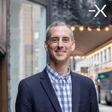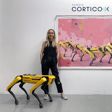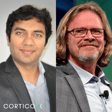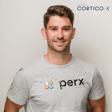Become a Creator today!Start creating today - Share your story with the world!
Start for free
00:00:00
00:00:01

Tackling health disparities with human-centered design, with Lin MacMaster, Mark Fithian, and Robyn Gilson
Despite America spending enormous amounts on healthcare, shocking health disparities still remain across racial, culture, gender, and socio-economic lines. The not-for-profit health system Providence provides a ray of hope. Providence is using human-centered design to put patients at the heart of their health equity agenda.
To discuss the Providence story, Will is joined by Providence VP Lin MacMaster, the Co-Founder of WideOpen, Mark Fithian, and Cortico-X VP, Robyn Gilson.
Get in touch with Cortico-X here.
Follow Cortico-X on LinkedIn here.
Transcript
Introduction to Cordico X and Podcast
00:00:00
Speaker
Cordico X is an experience-led transformation business that partners with clients and technology companies to drive digital acceleration. We are experience activists, passionate about elevating everyday human experiences through the belief that what's best for people is what's best for an organization. Reach out to us for a chat. A link is in the show notes.
00:00:34
Speaker
Hello and welcome to Speaking from Experience from CordicoX, where we speak to the people with experience of experience. I'm Will Kingston.
Health Disparities in Minority Communities
00:00:44
Speaker
The United States is the most technologically advanced, the most powerful, and the most economically prosperous state in human history. Surely that should mean its citizens are also the healthiest. Well, some of them are, but health outcomes for many others are a national embarrassment.
00:01:02
Speaker
Men in Mississippi have a lower life expectancy than men in Samoa. Black Americans die much younger than white Americans, and many Hispanic Americans still struggle to even access the healthcare system. Health disparities across racial, cultural, gender, and socioeconomic lines represent a fundamental challenge for healthcare policymakers and providers
Guest Introductions
00:01:27
Speaker
alike.
00:01:27
Speaker
My guests today have taken it upon themselves to address these health disparities, and they have done so by putting people at the very heart of their efforts. Lynn McMaster is the vice president of brand content and creative strategy at the not-for-profit healthcare system Providence. Mark Fithian is co-founder of WideOpen, a strategic customer experience consulting company. And Robin Gilson is VP and head of healthcare experience management at CordicoX.
00:01:57
Speaker
Mark, I'm interested to get your thoughts on why in fact, health care providers should care about this.
Healthcare Providers and Health Disparities
00:02:03
Speaker
So some more cynical people may just suggest that health disparities are a problem for policymakers. This is too big a problem for health providers to deal with. So they should just focus on their core business. Why should a health provider care about and address health disparities? I think they want to address health disparities. I don't dispute that. I mean, there are caregivers for a reason. They're in this industry because they want to help people. So I think that's you have to take that for granted and and realize that's the core motivation. And then why they may not, or all of these other issues that are surrounding this in terms of you know maybe just not knowing how to engage effectively with these diverse populations, not speaking the language, not being a Hispanic male themselves.
00:02:55
Speaker
There's a lot that that you have to understand in addition to ah to being an excellent provider of health care to be effective. So i think that's I think that's important to keep in mind. Well, this is indeed a very good segue from the why to the how.
Project Esperanza for Hispanic and Latino Communities
00:03:13
Speaker
And in the case of Providence,
00:03:16
Speaker
The team started its health disparity movement, and I use the word movement quite deliberately there, by honing in on the Hispanic and Latino community. This became known in the business as Project Esperanza. Why did you choose to start with the Hispanic community and then give me an overview of what Project Esperanza was all about? So Robin mentioned something called H-Cap Scores.
00:03:40
Speaker
And as we were looking at our H-CAP scores and also as we were beginning to look at how are we going to come together and better understand all of our segments, we participated in a syndicated research project called Reveal, which then looked at where were all of our patients along the journey from the time that you, it's almost like the pre-contemplative stage, but prior to coming into the system, how you came into the system, and then how you went through the system. And what we saw was we synthesized the data to understand that end-to-end journey for everyone. And what we found was is is that we were almost 30% lower with the Hispanic Latinx market than we were
00:04:31
Speaker
across any of the other scores, particularly in areas of estimating costs, which are a huge barrier, being able to explore financial health, being able to get assistance to help pay. So it was really a deep dive into data that showed us that where we want to begin is in the Hispanic, Latino, Latinx market, because we could make the most impact. And that also gets back to the fact that we are Hispanics are 40% of the population in California and Texas, which is the fastest growing US segment, and where Providence is is deeply penetrated. And so from those cores, we learned that there was, you know and the feedback is is that the Hispanic
00:05:19
Speaker
satisfaction was well below average. And so that's why we decided that we were going to start there because we saw the greatest need and the greatest ability to be able to focus in on that particular audience to to address those needs. So that's that's the why of why we chose Hispanic, Latina market. So that was what gave gave birth to Project Esperanza and in, you know, Esperanza means hope. And what we wanted to be able to do was to bring hope. And what we also know is is that in the healthcare world, the the kit we call ourselves caregivers, um otherwise known as employees, but the caregiver satisfaction is directly tied
00:06:18
Speaker
to the patient satisfaction is sort of an an infinity loop. So as we began to look at Project Esperanza, not only were we looking at patient satisfaction as being the lowest across the the industry and financial assistance, but what we were also seeing is is that you know in gaining input from our frontline caregivers in Southern California and Texas, is is that it was very difficult for them to be able to engage with Hispanic, Latino, Latinx. They felt that they were letting people down. And so as we embarked on this project, we began to bring people
Data-Driven Solutions in Healthcare
00:07:01
Speaker
together. As Robin said earlier, we began to listen and went through a very
00:07:06
Speaker
precise process in order to understand what what the caregivers were experiencing as well as the patients. So we brought a group of caregivers together to really begin walking on that journey. So in my simple mind, what I'm hearing is get the data, build an insights base, then engage your people to be able to understand the root causes behind some of the problems that you're seeing in the data.
00:07:34
Speaker
And then from there, still with those people, experiment, test, learn, and build solutions. I want to go through each of those in turn because I think that's a very powerful process.
00:07:45
Speaker
On the data side and the insight side, and Mark, I'll i'll throw to you first, are there any considerations when you're building out an insights program where you are looking at culturally diverse groups? For sure, especially in this type of work and especially in this industry, which is very, it's data driven. It's very clinically, it's ah it's healthcare, care right? It's all about data. You have to have the data. There's no question about it. You have to have the numbers.
00:08:14
Speaker
that help people understand and quantify. You also have to have the emotion. You have to you have to have the insight understanding the people that you are trying to ah help in this. And so that data, and I think Robin can talk about that. We we kind of coined it a ah fact pack. But that fact pack is loaded with information that's quantitative and also qualitative. And you you can't have one or the other. You have to have both.
00:08:44
Speaker
in order to do this kind of work. I would say, if I can just add on top of that, just as a build, you have to have the people who are in and of the culture as well as the work participate. When we gathered the team that was going to work on this, the their lived experience as children and as Hispanic, Latino, Latinx individuals,
00:09:12
Speaker
and the experience their lived experience in the health system was key to our understanding of what the journey was like. So you have we can look at quantitative data and say, gee, there are lower scores. But once you get the people who are involved with delivering the care and in and of that community to really begin to unpack what it is like to try and go through a healthcare journey. I mean, the stories that we heard would bring you to tears. you know A little seven-year-old girl with her mother holding her hand as her mother is being told by the doctor, and she has to interpret for her mother that her mother has a very, very severe cancer. And what the likelihood of her living through this was going to be.
00:10:10
Speaker
I mean, it was through those stories and those understandings and their dedication to really beginning to understand what is it that is going on from an operational and a process standpoint within the organizations that are delivering those types of experiences and then what is it that we need to do? How do we ideate in order to build solutions to those problems?
00:10:40
Speaker
very powerful. Just before we then go deeper on that ideation process, I have one more question on the insights piece. And Robin, I'll go to you here. Lynn mentioned at the start of the episode that we are dealing with cultural groups that have been disenfranchised from the American healthcare care system. That must mean that there is a lack of trust from many of the people within those communities.
00:11:09
Speaker
How do you go about engaging with, say, people from the Hispanic community where there may be historical feelings of mistrust between themselves and and healthcare providers or healthcare groups more generally? So, Lynne very much hit on it and
Community Engagement and Trust Building
00:11:28
Speaker
what was key in how we learned, and we learned not just for Providence, but to Lynne's point of when we saw this this deficit We dug in and realized it's really not just for Providence. It's actually all health systems that see this deficit in terms of the sentiment. And what shocked us was that you go to other industries where you've seen more of that progression and to your point on trust, it's different.
00:12:01
Speaker
And they tend to, the Hispanic Latinx community, it's known they tend to give higher ratings than the, than the average. They're a little bit more forgiving. And so it made us, you know, sit back and I would say the way to reach when you're, you know, we did the reveal a check study in a blind manner so that we weren't fighting that element of trust. We also.
00:12:28
Speaker
use partners and influencers, groups that they do trust to listen. But the third element that Lynn was mentioning that is really the magic is when you bring the people into it. And in this situation, we got to witness something very, very beautiful in the stories Lynn was describing because the individuals in the situation that are the employees had, it struck a chord and they felt the door open because they not only ideated like you would see in human centered design by knowing their experience as an employee, they could relate as a patient, but they could relate as well as a family caregiver. And they shared a problem. They felt the door was opened and the stage was built to talk about something that some of them said has been going on for two decades and where
00:13:23
Speaker
Healthcare, care again, to Len's point of it not being a system, is behind other industries in really listening to those that are going through it, involving them in problem solving it, understanding the root of it, where we started and sparked a conversation that was not just lip service to cultural relevance, but what is the true meaning of being culturally relevant And let's make sure we understand the feelings and experience of what's happening now and what's been happening over the last decade and why it's creating a barrier and why it's creating a barrier from that point of initial access. Help us understand if it's your mindset on the way care is received in Mexico, it's different than the US. So does it lead to certain myths that need to be debunked?
00:14:18
Speaker
Is it related to fear of being reported because of immigration status? Is it the nucleus of the family, you know, the need to bring the whole family along and not feeling that's the case or the language barriers? So in this case, it was so much more than just about language. It was deeply rooted and a need for all of us to understand and adopt a discussion around the importance of cultural relevance.
00:14:48
Speaker
You know, Will, I want to bring one other thing up, and I think that it's worth talking about. And I know that Robin and Mark and I can probably unpack for you. When you look at what the impact is of not having the right experience for this population,
00:15:09
Speaker
What you see is is is that their health outcomes are significantly lower. So if you get get back to that idea of health equity and the work that Providence does to ensure the health of a community, what you're seeing is is is that you have a disintermediation of the continuity of care. And what that means is is is that it's not only important to get someone in for care,
00:15:37
Speaker
but they have to maintain that care. And what you find is is that somebody will go into the emergency room. They don't speak English. We don't have, many systems don't have in language for the patients. They don't know how much it's going to cost. They then go through this very complicated process and many of them leave. And then what happens is is that they come back sicker than they were when they came in. You also see cancer patients. They'll come in, they'll be they'll be diagnosed, and then there's this gap between diagnosis and being able to get care. And that's one of the greatest issues. You brought this up earlier, Will, and I hate to go back to go forward, but when you asked about why in the Deep South you have higher mortality rates,
00:16:37
Speaker
You have higher mortality rates because you have organizations that are going in and they're doing screenings. They're doing cancer screenings. They're doing other screenings. And then that individual can't get to care. And if they do get to care, they don't have the continuity of care. We have a responsibility as a nonprofit Catholic health system, as you know any other health system has.
00:17:02
Speaker
which is to ensure the health of the community. And if you cannot ensure the health of the community, but the health of the individual, you are not going to ensure the health of the community. And those are some of the things that when you do a project like Esperanza and you go down and understand the root cause issues,
00:17:23
Speaker
and then begin to take the people who have lived experience doing this, who are caregivers, as well as ensuring that you listen to patients, you then begin to understand what is it that we can do that is going to begin to close those gaps.
Human-Centered Design in Healthcare
00:17:41
Speaker
This is a fascinating insight, the disintermediation of the continuity of care. I imagine you can only understand that by understanding the journey that they go through. You need to be able to see the journey to see where there are the disconnection points in that journey. And this brings us to the concept of human-centered design. Mark, give me the four dummies explanation of human-centered design, what that means, and then perhaps how it was used in Project Esperanza to be able to understand those disconnect points for Latino and Hispanic patients. The simple version, I guess, would be it is about solving a problem through the understanding of the the customer, in this case, a Hispanic patient in Esperanza, and that if we understand that we can
00:18:36
Speaker
If we understand that fully through their perspective, we can create solutions that are going to be more effectively adopted by ah but by these and those customers. I mean, that's really the center of it as opposed to someone coming in and saying,
00:18:53
Speaker
That's a problem. I'm going to design a solution to fix that problem and not having that human insight in that process. And and and in this case, and in many cases of design-centered work or human-centered design, you've got the customer co-creating this with you, right? In this case, we had people who were of the Hispanic community, people who were caregivers, meaning employees of Providence,
00:19:19
Speaker
they were co-creating it with us. This is a radically different world to if you were to speak to a healthcare CEO in the 1970s where you perhaps we would have a strategy team or an operations team who are trying to solve complex problems. In this instance, you've got customers coming in co-creating, you've got Caregivers acting out scenarios in hospitals this is a fascinating way of working robin i want to pick up that first place that mark mentioned of actually bringing customers in. Not just to understand them in the many insights and interviewing stage but then in the co-creation and design stage which i think some people listening may find surprising. What are some principles for how you go about actually co-creating effectively with customers or in this instance patients.
00:20:03
Speaker
So to co-create effectively, I think one of the core principles is creating personas.
Badge Buddies for Communication
00:20:11
Speaker
So we let the, you know, put the customer at the middle, but we created different personas that the caregivers, the employees in their different roles, they took off their day job hat if they were a financial counselor, if they were a registrar,
00:20:30
Speaker
if they were in clinic operations and they put on the hat of that persona. So as Lynn was describing, they took and had an immersion of stepping into the shoes, walking in the shoes of the patient so they could see it from a different vantage point, so that they could feel it, very experiential.
00:20:51
Speaker
and The surprise for them was you know it brought to life the lived experiences in a whole new way. It wasn't just their own personal experience. It wasn't just the stories that they had from their family. They were caregivers at facilities and they didn't realize some of the roadblocks. They knew that there was a roadblock in general for the community.
00:21:18
Speaker
but the roadblocks that existed where there could be some very simple solutions that we'll tell you about later called Just Do It. But the story that Lynn described, a beautiful element of it, and I'd love for Lynn to elaborate or mark, is an outcome, you know an idea that surfaced purely because of that kind of immersion, creation of a persona, dedicating time to let people go through different scenarios and truly experience the lived moments, but in the health system resulted in something called badge buddies, which is a very simple, just do it. It's not a, a you know, slick digital prototype, but it's something that is having a big impact. We had 60 projects that emerged from this and three big bets, 60. And then we had about
00:22:12
Speaker
seven or eight, just do it. The first one is called a badge buddy. So if you think about that experience and you're going across, so think of yourself walking across a hospital campus, there are people, you see doctors, you see nurses, you see people with jackets on and you think, okay, but you can't speak to them because you don't know whether they speak Spanish or not. So you don't know who you're going to ask to try and find the financial aid office. So this idea sprung up of, can you just put a badge, a pin on for people who speak Spanish. And, you know, how can I help you is on the, on the badge buddy so that they know that they speak Spanish. It's in language. And so that simple, simple idea has now been piloted in four of our, we call them ministries or our hospitals. And
00:23:08
Speaker
First of all, the satisfaction level of the caregivers has gone up exponentially because people want to be able to help. You don't come into medicine because you don't want to help people. You come into medicine because you want to make a difference in people's lives every day. So caregiver satisfaction has gone up, patient satisfaction, and you've eased the way.
00:23:30
Speaker
of that patient to be able to get to care with something that's that simple. It's a useful example because I think in 2024 we're often conditioned to think of innovation as a sexy new app or a new technology implementation or something expensive and whiz-bang and often it is those simple interventions that cost next to no money that can have a profound impact.
00:23:54
Speaker
This actually also raises the question of, well, how do you compare a badge buddies type of initiative to a more expensive technology implementation?
Project Prioritization and Impact
00:24:03
Speaker
And that goes to prioritization. So from what we just heard, heaps of great ideas came out of this. I imagine there had to be some form of prioritization to know what to attack first. Mark, what was some principles around prioritization that the team were considering to try and focus their efforts?
00:24:19
Speaker
It starts with knowing there's intention to fix these things at the organizational level. So you had people at the table who are leaders in the system who said, yes, this is important to us. And we are going to be there to make this real. If we didn't have that, it was just an art project. It was a creative exercise. so And with that comes an understanding of the business and what drives the business.
00:24:48
Speaker
and the clinical issues and outcomes that we need to affect. And that really helps us kind of put the the business backdrop on prioritization to say, okay, these have big impact, potentially big costs. We need to kind of think about them differently and prioritize them differently. But throughout the process, we had the people who were ultimately deciding what the priorities were at the table, right? And we were,
00:25:15
Speaker
providing them with the information that they needed in order to make that decision. So it wasn't just throwing a badge buddy on the table. Say, hey, what do you think about that? Think that'll work? We had to rationalize this and say, here's here's the case for how the this will impact the business. And then there were some specific like stage gates. And Robin, maybe you can talk about some of this in the process where we had a Shark Tank type exercise where they helped us to window down some of our ideas so that they were more implementable. you know They look at them with kind of a sense of their area of the business and say, I like this and I can make it work even better if we can change it a little bit like this. But there there was a lot of prioritization built knowing that has to happen, knowing we have to execute this stuff. There was a lot of intention around prioritization from the outset of the process.
00:26:06
Speaker
Mark, if I can build on this, I mentioned earlier that there's a moral imperative. There's also a business imperative. And so we also looked at the dollarization and the impact of the changes that we were looking at. And that was a filter that we looked at as well. And if you look at it from a business standpoint, we estimated from four key areas that over a five-year period, we would be able to save. So this is real savings somewhere in the vicinity between 30 million and $70 million dollars over five years through the implementation of the ideas that we that we had generated. And at the end of the day,
00:26:56
Speaker
If there are no dollars, there's no mission. And we're a mission-based organization, and the impact of being able to save those dollars to be able to reinvest in the community. And you talk about CEOs, CEOs from the 1980s. Look at CEOs from 2024. How many health systems in this country have realized a customer experience function within the organization. And this is scratching the surface. This is one project. This is one segment. And you not only look at that, but then you're meeting your moral imperative for the health of the community and bettering that community.
00:27:43
Speaker
seen Many experience initiatives fail because they tick the warm and fuzzy box, but they don't tick the ah ROI box. So the fact that those two things were brought together here is very powerful. One question to you, Robin, because it picked up on a little nugget that I heard from Mark there, which was a Shark Tank concept. So it sounds like there was an element of fun, an element of theatre as part of that process. What did that look like and why was that important?
00:28:09
Speaker
So it was a part of our prioritization stage gate and it was a friendly shark tank. We sometimes called it the baby sharks so that there would be fun and it embraced judges. We brought in in that effort to make sure we were staying close to the end customer. We brought in experts that were external, that were cultural relevance experts. We brought in operators from other parts of the business to LensPoint that were looking through the lens in terms of the end impact, the bottom line, in addition to individuals that were focused on the caregiver engagement, so that caregiver satisfaction, because to as Lynn was saying earlier, we realized we're creating obstacles. Obstacles create ah retention issues. If it's too hard for someone to do work, you know, there's a dollarization of that. So this shark tank was the first stage gate
00:29:07
Speaker
where these outside judges and and internal experts came together and they judged and they scored all the ideas and they created that first set of, we recommend these, we think these will make a difference. There was a scoring mechanism so that they had to push themselves to think about, is this really something that will be different? Is this something foundational that will help you break through and do we feel that the organization is ready for it, you know the readiness factor. And then it went from there to a group of champions. We had a group of champions that represented experts and leaders from across the different business lines. So that before it came to sponsors like Lynn, we had pressure tested to make sure we could support and execute on those just do it and foundational and innovative ideas that were being brought to the surface.
00:30:04
Speaker
And what I'm really proud of ah along with the team is that it resulted in a 2025 action plan and a movement. We are rapidly running short of time, but I have one final question that I will ask. This movement, as Robin just phrased it, has been recognized by the US Customer Experience Awards, where it cleaned up. ah The healthcare ecosystem across the US is now recognizing this as a shining light to address health disparity. It's been enormously successful. Lyn, I'll start with you. What piece of advice would you give to someone in a similar position to yours at another healthcare provider?
00:30:42
Speaker
on how they should go about starting this journey?
Initiating Health Disparity Projects
00:30:46
Speaker
Well, that's a great question. What I would say is that you need to get the right leaders involved who have passion for the project and who are willing to take a risk and invest because it is not standard fare for most health systems. It's something that they don't necessarily understand.
00:31:12
Speaker
When you think about health systems are operationally driven, you know they're not necessarily market driven or brand driven. And so you have to get the right people at the table who have passion for this and who understand what the impact is. And the other thing that I would suggest is is that when you're talking about it, you need to be able to reference what the ultimate impact of this is going to be for the community, both that Moral imperative as well as the business imperative and mark your words of wisdom this kind of work in health care is a teachable moment for systems and You really need to be able to tell the story around that effectively in the organization so that they Share that excitement and understand that intentionality around this work and that it can be done that we can be better at this work We can do it
00:32:08
Speaker
I think that's critical. and i The other part of this is you really have to let ah the caregivers, the people on the front line, they have to own it. It's it's the power to the people. like If you let them own it, the energy will just come naturally and the ability to sustain that in the culture And Will, one last thing that I would say, which is going to be, I think, rounded out because it gets back to the question that you had about trust, the question about brand, is is that when you do this, when you put the customer at the center, as we learned with Esperanza, when you are able to meet their needs, when you when they feel heard and they feel seen, you build trust.
Building Trust and Brand Reputation
00:32:56
Speaker
And when you build trust, trust is what is is the foundation of our of the greatest brands. And so when you're able to build that trust, you're going to build your brand, you're going to serve your community, and you are going to do well by doing good. Lynn has just given me my video teaser for the episode.
Closing Remarks
00:33:17
Speaker
Lynn, Mark, Robin, congratulations on an outstanding movement. Thank you for all of your efforts and thank you for coming on the show today. Well, thank you. Thank you.



















